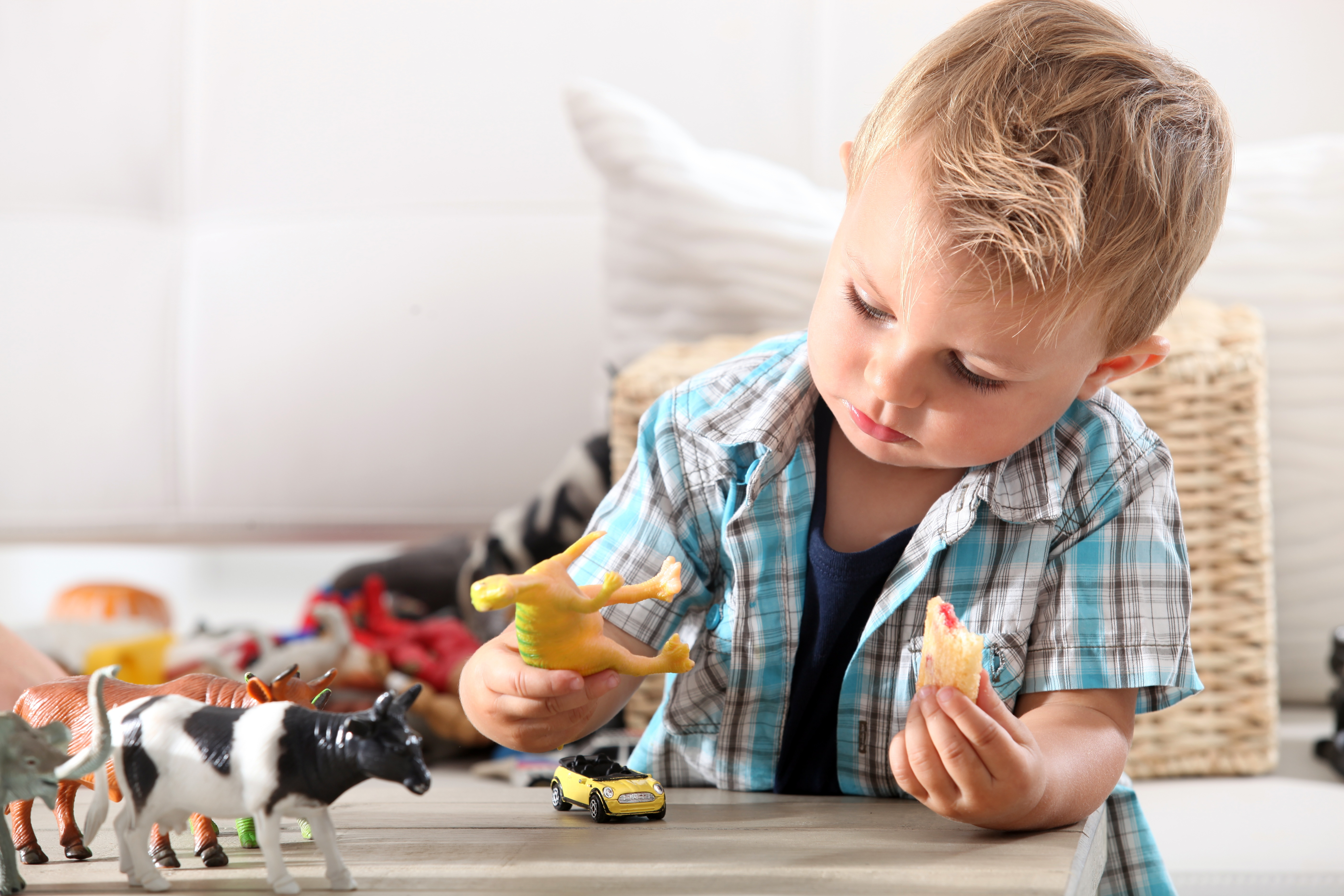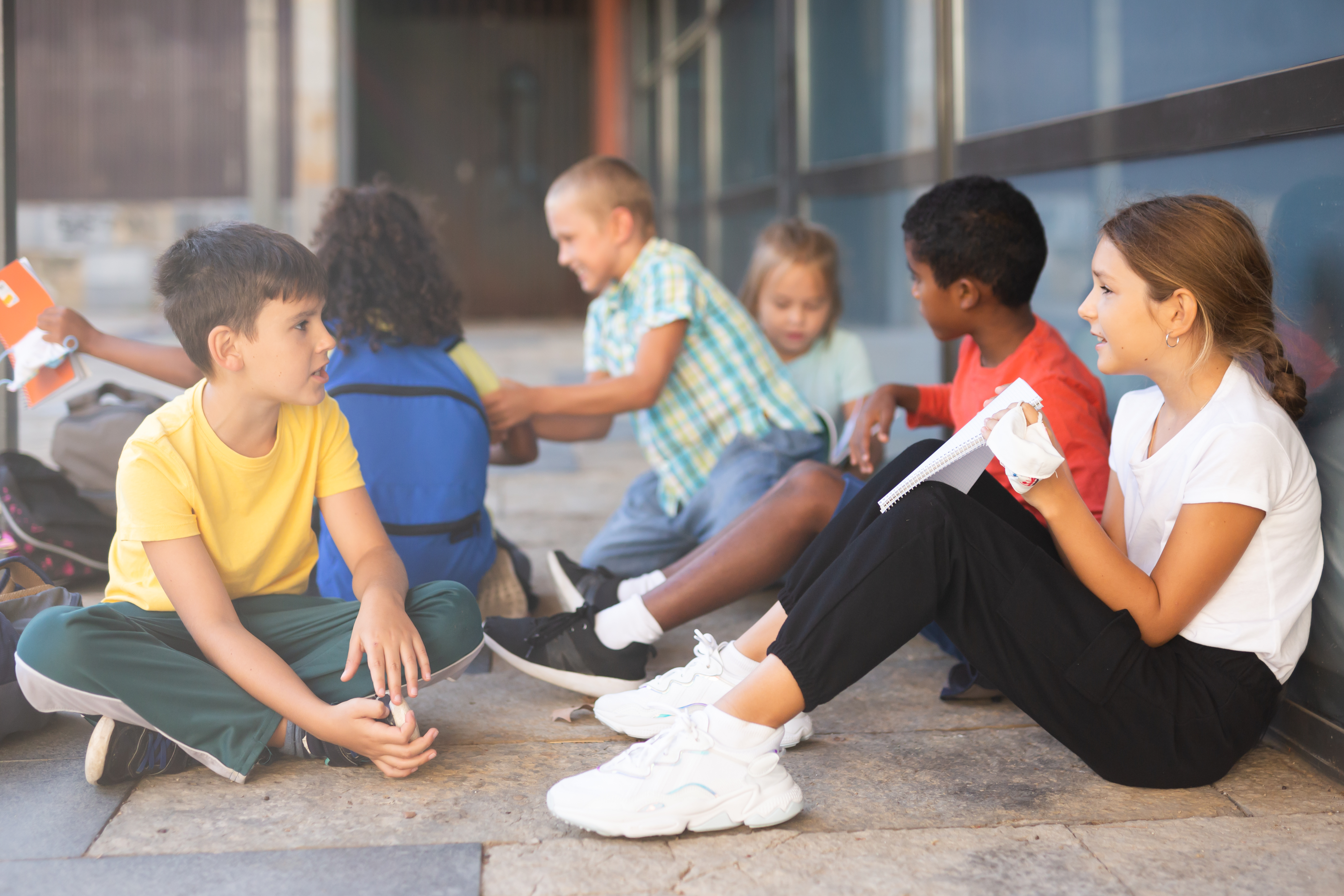You’re sitting in the living room, and suddenly, you hear your child talking to someone. You investigate and discover that they’re talking to themselves, a toy, or an imaginary character. Parental worry sets in, and you question if this is normal behavior.
Kids talk to themselves for various reasons, including social skills practice and creative play. It’s generally a good and essential part of a child’s overall psychological development.
There are several things to know about why kids talk to themselves, whether good or bad and when to be concerned. This article will cover six things to know about why kids talk to themselves and if it’s normal.

Things To Know About Why Kids Talk to Themselves
We’ll explore scientific theories and research, why self-talk is used for normal development, benefits, how to respond to those using self-talk, when to be concerned, and accessible resources.
1. Scientific Theories and Research About the Use of Speech
Various theories and research have been done to evaluate the use of self-talk and what purpose it might serve. Generally speaking, psychologists and researchers in this area look at the development and process of language and speech in young children and how that translates into their functioning as they mature.
Jean Piaget, a Swiss psychologist (1896-1980), called self-talk “egocentric speech.” He believed that children were selfish and self-centered, unable to use logic to combine or separate ideas and apply them in social situations.
Piaget argued that this egocentric use of language results from cognitive development and not vice versa. Psychologists today study this theory for speculation and discourse.
Lev Vygotsky, a Soviet psychologist from the early 1900s, called self-talk “private speech.” He felt that private speech was essential for social development, noting that as children mature, they differentiate between social and private speech.
He viewed human development as a social process through which children gain values and beliefs. Private speech facilitates problem-solving skills as well. A majority of psychologists today generally agree with and support Vygotsky’s research.
In 1974, Alan Baddeley and Graham Hitch, British psychologists, researched how people use subvocalization to move information into their working memory. They theorized that when trying to do a visual and verbal task that’s challenging to the memory, subvocal sounds and words may be used to hold the information in place.
Working memory is a way to retain information quickly to perform mental tasks on received or perceived information. This process uses the combination of executive functioning, visual and auditory support, and the sequencing of information to complete tasks. It’s a crucial process for learning, reasoning, and comprehension. People cognitively need self-talk for their working memory.
Adam Winsler, a psychology professor at George Mason University in Virginia, encourages preschoolers to use self-talk. His research in 2008 found that 5-year-olds are more successful on tasks when they self-talk than when they’re quiet.
Winsler’s study also showed that those diagnosed with Attention Deficit Hyperactivity Disorder (ADHD) or Autism tended to talk to themselves more. Of particular note, Adam Winsler found that if the external speech was impaired in a child with Autism, the internal speech wasn’t necessarily impaired. Their usage of self-talk was an essential tool for working through and completing tasks.
These and other psychologists’ theories and research have helped form our understanding of language acquisition and its use today. Generally, it’s viewed that self-talk is an essential part of a child’s development.
2. Reasons Why Kids (and Adults) Talk to Themselves
You’ve now read about some of the research, but let’s dig deeper into the “why” by looking at some examples of self-talk in use.
For example, you overhear your toddler talking to her stuffed animal. She places the friend in front of her, making eye contact. You hear her asking if she can play with the bear’s toy. She tells the bear, “thank you,” when she gets the toy. Your toddler is practicing how to share, make face-to-face eye contact, and use positive language for gratitude.
In another example, your son sits at the table working on math homework. He mumbles to himself, looking through notes from earlier in the day. He reads the first step for solving the problem out loud and then repeats it as he applies the step to his homework. He goes back and forth, talking over the notes and applying them. Your son is verbalizing steps for a difficult task to help him focus in a detailed manner for success.
In another scenario, your child is running around outside by herself. She looks behind her as she runs and tells an imaginary friend to follow her and come along. They soar around the yard exploring only things they can see. Here your child is being innovative and practicing social skills.
Your son is learning to drive the car with you as a passenger on your way to the museum. The GPS is on and telling him where to go. Your son repeats the directions each time he hears one, and as he completes the task, he comments, “Okay, I got this,” as if he’s talking to the car. This inner dialogue shows that he’s processing the steps to follow, encouraging himself along the way.
Much like learning to walk as a young child, children must practice using language and exploring the world with words. As they mature, children often use self-talk to cope with and process more challenging tasks, emotions, or situations. This practice through role-playing, imaginative play, skill work, and life skills is necessary to explore social relationships, regulate emotions, and guide themselves through tasks and learning activities.
3. It’s Normal Behavior in All Stages of Life
You go into the pediatrician worried that your child talks too much to himself. You ask if this is normal behavior with a tremble in your voice. Many present-day doctors and psychologists will answer you with “Yes, this is normal!”
Let’s briefly look at what normal might look like for different age groups.
Toddlers may talk directly to themselves or with an inner dialogue, a doll or stuffed animal, imaginary audiences or friends, or even face-to-face with themselves in the mirror.
Preschoolers and young children play in pretend worlds with imaginary friends. One hundred fifty-two preschoolers were part of a research project to examine their developmental play with fictitious characters.
The results showed that 65% of children up to the age of seven had an imaginary friend at some point. Interestingly, those who didn’t have an imaginary companion scored lower in emotional understanding during the study.
School-aged children may be heard talking to themselves as they work through challenging academics, a puzzle, or practice for a public presentation for school.
Kids will also commonly talk to themselves throughout the day. However, many kids will stop using self-talk publicly when social pressures from peers are in place. They learn to be quiet when having conversations while waiting for a turn to speak.
Students also learn in school situations to be quiet while learning from a teacher or presenter to pay attention to instruction and information. A school day or learning at home requires reciprocal listening and speaking. However, you may notice that students will self-talk when applying directions to a task or learning new information to create personal understanding.
Even adults will work through detailed steps by speaking them out loud. This might be seen when trying a new recipe or putting together a complicated piece of new furniture. Adults may walk into the kitchen and ask themselves why they came in there in the first place, trying to provoke their working memory.
Adults may create a clever verbal way or mnemonic device to remember something. Adults can role-model to their children how talking to themselves is a normal and acceptable thing to do.
As you can see, self-talk occurs in normal and acceptable ways during all stages of life.

4. The Benefits of Talking to Yourself
Talking to yourself may help to self-regulate emotions and develop strategies. Kids who do this may be better at controlling emotions and behavior when completing complex tasks. This benefits both intellectual and emotional development.
An active imagination is a great thing. It promotes creativity and innovation, which the world needs. Children can find friendship, entertainment, and support from an imaginary playmate. Imaginary play also offers the benefits of:
- High-level social cognition
- Increased sociability
- Appropriate coping strategies
- Problem-solving
- Emotional management
- The opportunity to explore ideas
- Practicing behaviors and roles in social relationships
Listening to another person use self-talk gives you insight into what they’re thinking about. This is an opportunity for you to get to know your child and what they’re processing and learning.
Lev Vygotsky, as mentioned above, saw self-talk as a transition between a person’s inner and social speech usage as they prepare and practice to interact with others.
Talking to yourself can be an effective tool for high cognitive demand for things such as remembering details, completing steps, or working through a task, for a person no matter what age they are. Self-talk prepares the person for communication with the outside world.
5. How To Respond to Kids Talking to Themselves
Here are ways on how you can respond to your child when they are talking to themselves:
- Playfully respond in an engaging way with their role-play. If they’re talking to the doll, you can too, or consider inviting the friend to the dinner table! This type of response will help to teach the difference between imaginary and realistic situations. This allows the adult to foster appropriate conversation skills.
- Ask your child about their imaginary friend. This will help you learn about your child and their interests and may give you insight into how an imaginary friend is helping them to develop. If the imaginary friend isn’t behaving appropriately, you can help your child learn how to set up boundaries and expectations for proper behavior.
- Avoid stifling their inner speech. It can send a confusing message about something they’re naturally doing if you do. Remember, kids need this internal dialogue to learn and grow in their social development.
- Abstain from comparing your child to other children. Kids have different personalities and home situations. For example, during playtime, structured play may have fewer creative opportunities that prompt inner dialogue than free play might have. A child entertaining oneself is more likely to engage in self-talk if there are no set rules to follow in a playtime scenario.
- Encourage kids to engage in self-talk. Children with ADHD, Autism, or other neurotypical differences should be motivated to do self-talk as well. The benefits of using self-talk to support their working memory and provide self-encouragement will help them to accomplish tasks and work through the self-regulation of their emotions.
- Work with a speech pathologist. Your child may need to work with a professional if they have a language deficit such as Social Pragmatic Communication Disorder or Selective Mutism. While these could affect language output, they may not necessarily affect their inner dialogue.
- Respect others’ self-talk. Don’t jump in to fix or correct what they’re saying. Use their words as a scaffold and role-model appropriate responses.
- Role-model self-talk. Adults often self-talk when stuck in traffic. Use this frustrating experience to demonstrate positive self-talk regarding a stressful situation. You could say, “I don’t like being stuck in traffic. I’ll have to take a few deep breaths to feel patient.”
- Express gratitude. Again, adults can role-model emotional regulation by thinking and saying positive thoughts aloud. For example, “I’m so thankful I’m strong enough to shovel the driveway today.”
- Point out thought processes. Educators often use “Think-Alouds” as a verbalization strategy to read and monitor their comprehension. It’s a good strategy for modeling how to construct meaning.
6. When To Be Concerned When Kids Talk to Themselves
While many children (and adults) may use self-talk for various detailed or working memory tasks, there are a few instances when self-talk could become concerning. In these cases, it may be beneficial to contact your child’s pediatrician or a pediatric psychologist.
If a traumatic event occurs, and suddenly the frequency of self-talk increases dramatically, it could cause concern. Your child may be trying to process the traumatic event and may also need professional help coping with the situation.
Sometimes a child’s imaginary friend is scary. The pretend playmate may be disruptive, aggressive, frightening, or a rule breaker. Children with this type of friend may feel like they have no control over the friend’s behavior. This relationship can help a child navigate hard times and difficult social situations, but they may need support to do this with a professional.
Some parents may wonder if an imaginary friend or vivid imagination is a sign of schizophrenia, hallucinations, dissociative disorders, or psychosis. The symptoms of these disorders often present between the ages of 16 and 30. Childhood-onset schizophrenia, seen between the ages of 5 and 12, is rare. Some symptoms of childhood schizophrenia include paranoia, mood changes, hearing or seeing things that aren’t there, and sudden behavior changes.
Some children with other cognitive disabilities, such as Down Syndrome, are more likely to maintain friendships with imaginary playmates into adulthood. This is considered to be normal.
Mental health professionals are experts at figuring out other reasons why self-talk frequency occurs more often. Increased self-talk could happen if a child is feeling excluded, rejected, lacks reciprocal communication from others, or has anxiety. Although rare, in more severe cases, a professional can determine if there’s an underlying condition such as schizophrenia.
Resources To Support Kids Talking to Themselves
There are some resources that you can consider if you’re looking for additional information or support.
You may find a psychologist in your state. Many offer telemedicine as well.
Look for playgroups in your area. Consider checking out social activities at your local library.
Purchase books and play-tools from Amazon.com such as:
- Tyson White Social Skills and Activities for Kids. This book helps guide parents in helping their children with different personality types in making, nurturing, and establishing relationships.
- Mary Nhin’s Communication Ninja. This comedic book provides fun illustrations with positive strategies to help those struggling with communication or social situations.
- Diane Alber A Little SPOT of Emotion. This comes with eight round plush toys with emoticon faces and a special edition hardcover book called “A Little SPOT of Feelings.” The plush emotions are Anger, Anxiety, Confidence, Happiness, Love, Peaceful, Sadness, and Scribble. Inside the book are a mirror for self-reflection and a poster to support conversations about a child’s emotions.
Final Thoughts
That’s a lot to ponder, so what did you think? Did you find yourself reading portions out loud? Perhaps you had some inner dialogue about how the information applies to your own children?
The most important thing to remember is that when kids talk to themselves, in most cases, it’s normal. The reasons why they do this are for healthy cognitive and social development.
Self-talk provides the benefits of problem-solving, emotional regulation, and the utilization of working memory to complete tasks. It gives kids a safe space to explore unlimited and unrestricted imaginative play for innovation and social situations practice.
Sources
- Today’s Parent: Is it normal for your kid to talk to themselves?
- Science Daily: Preschool Kids Do Better When They Talk To Themselves, Research Shows
- MASTER Institute: Self-Talk and Thinking in Preschool Children
- Simply Psychology: Lev Vygotsky’s Sociocultural Theory
- Simply Psychology: Preoperational Stage – Egocentrism
- Simply Psychology: Working Memory Model
- Reading Rockets: Think-alouds
- APA PsychNet: The Characteristics and Correlates of Fantasy in School-Age Children: Imaginary Companions, Impersonation, and Social Understanding.
- Healthline: Social Pragmatic Communication Disorder: Symptoms, Treatments & More
- SMart Center: What Is Selective Mutism?
- Psychology Today: Find a Therapist
